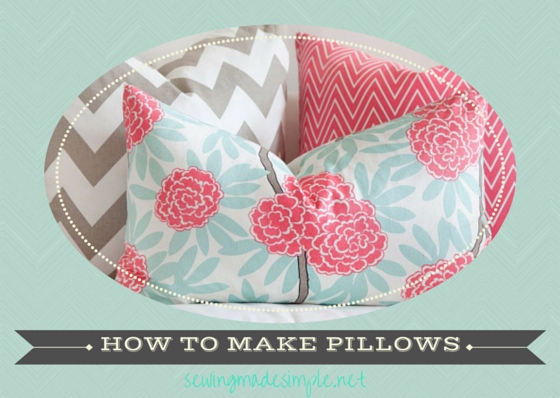Decorative and useful pillows are one of the easiest projects to complete as a first time sewing apprentice. This will be very simple to do since we’re going to use something you probably already have around the house.

If not, below is a material list that you will need to complete this project.
Remember, we love pictures. So if you want to snap a few and send in to us, you may get lucky and see your project on our page!
Material List
- 1 bag of poly fill (this is the cotton like filling that is found in most pillows. If you would rather have a denser pillow, you can also purchase a bag of foam fill, which are small cubed pieces of foam.)
- Pillow Case (if you would like to make your own, there are instructions for this at the bottom of the page.)
- Spool of thread (get a color that matches your pillow case or material, and you can use this for both the bobbin and the needle thread. For decorative pillows, you can use a different color for accentuation.)
- Pattern- Do you really need a pattern? That is dependent on the type of pillow you want to make. For this lesson, there is no pattern required since we are using a pre-made pillow case and that hard work is done for us. If you want to make one for yourself, there are instructions for a pattern below.
- Pins with or without a pin cushion and 1 hand sewing needle.
Sewing Your Pillow
1. To start, turn your pillow case inside out. There will be very few times you will EVER sew right sides out.
2. The open end of your pillow case is what you are going to sew today to make your enclosed pillow. You will need to pin the finished edges of the pillow case together, so that you can sew them into a perfect seam.
3. Starting at one end, lay the pillow case out flat and insert pins near the flat edge every 6 inches. This will hold your material together so that when you start sewing, its length does not get mismatched. (I had this misfortune when I first started out. I ended up with a pillow case that had about 3 inches of ‘extra’ material bunched up at the end. Complete disaster. I had to tear out all the stitches and start again.)
4. Raise the pressure foot on your machine, using the lever on the rear near the needle. Take the pillow case with the pinned edge in your right hand, and lay the farthest edge under your pressure foot. Lower the pressure foot back down. so that it lies adjacent to the pinned edge of your material.
5. Select your straight stitch on the machine, and begin by pressing down on your foot pedal to create around 1 inch of stitching on the material. Press your reverse stitch lever or button, and go back over the same stitch until you get to the very edge of your material and stop. Release the lever and now you will begin the long stitch that runs the length of the pillow case to the other open end.
6. Start slowly, and watch the edge of your material on the right hand side. Try to keep it aligned with the straight marks on your pressure plate, which is the metal plate that the needle fits down into on the machine when sewing. This will keep your material straight, and your stitches in a straight line. If you see that it is going a little off kilter, that is fine as this is your first project and you will make mistakes. Simply slowly pull the material back towards the line on the pressure plate while sewing.
7. Once you get to the last 4 inches or so of the open end, it is time to get ready to stuff your pillow. Open the stuffing you purchased, and have it nearby. Leave the needle in the down position, so that you are able to move the material without causing any missed stitches or breaking of thread.
8. Begin to pull the inner portion of your pillow outwards. When you have completed this, you will see the outer portion of the pillow (the side you would actually lay your head on) is now on the outside instead of the inside. You will see that you cannot complete sewing in this manner, so you will need to remove the pillow case. Raise the pressure foot lever and pull your material out of the machine, cutting the threads from the machine as you do so, as close to the fabric as you can without cutting the fabric.
9. Now you will stuff the pillow with your fill. Once complete, you will pin the edges together where you just stuffed the opening. Thread your hand sewing needle with the same thread you have been using from the spool pin on the machine and knot at the bottom of the thread before beginning to sew.
10. You can use a whip stitch to complete these last few inches, which is one of the easier stitches to complete. Insert the needle on the inside of the pillow near the last machine stitched area so the knotted tail is inside the pillow. Pass this completely through both layers of material, in a line close to what the machine stitched area looks like, up and over the edge of the pillow to the other side. Pull this completely through and then insert your needle on the other side of the pillow, and do this over and again until you have reached the last stitch.
11. At the last stitch, you will put the needle down into the material’s corner that is open, and push it through to the outer edge, which will look like a pucker. Use the needle to go in and out of this puckered area twice, pulling the thread almost all the way through on the second time. Lead the needle through the loose end of the thread twice, and pull tightly to create a knot. This knot can be pushed down into the pucker and hid for your finished pillow.
Pattern
The average household pillow varies in size, so to make a pattern using your own material, follow these steps;

- Measure a pillow in your home and add 2 inches to the length.
- Measure your material in the same manner, and mark the edges with an ink pen or a material marker. (The sides with the marker or pen on them will be used inside the pillow, so no one will see them.) If you want to reuse this pattern numerous times, use a brown paper bag to draw the pattern on instead of simply marking your material, then pin the bag pattern onto your material and cut.
- You will have one additional step that is not mentioned above if you do this with a pattern of your own. You will need to sew up the other 3 sides of the pillow prior to completing the above steps.
- Simply sew them together as described above, before turning inside out.
- Remember to always put ‘wrong sides’ or the inside portion of your material together when you pin it, so you don’t end up with a right side and wrong side sewn together.
Or maybe watching this video tutorial I found on Youtube will help you more.
